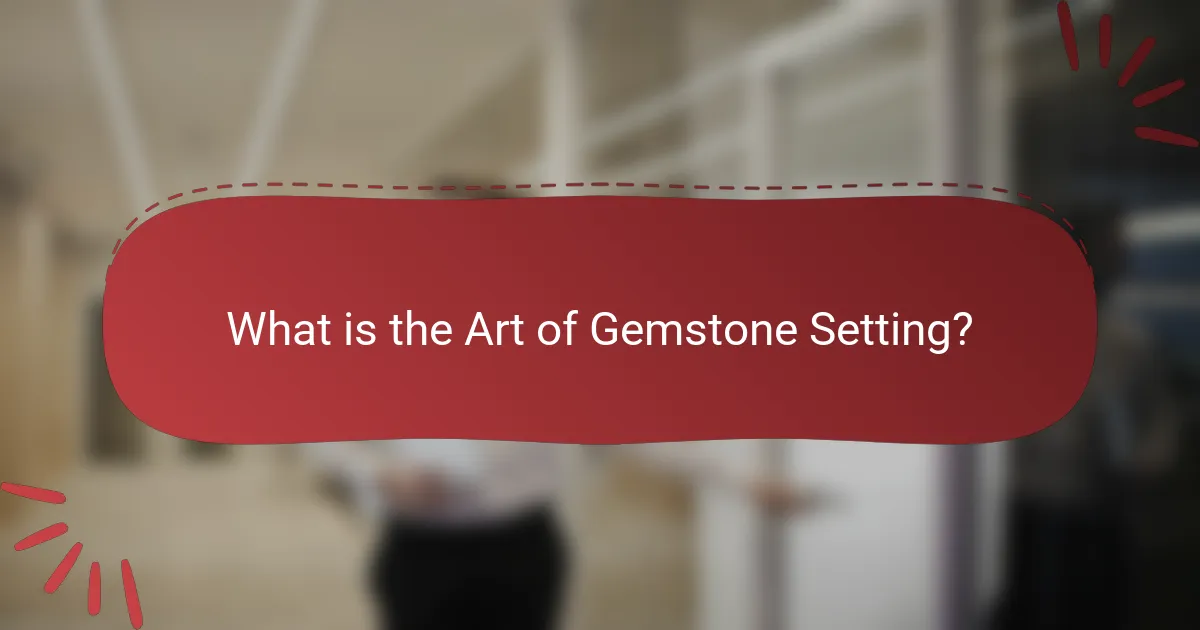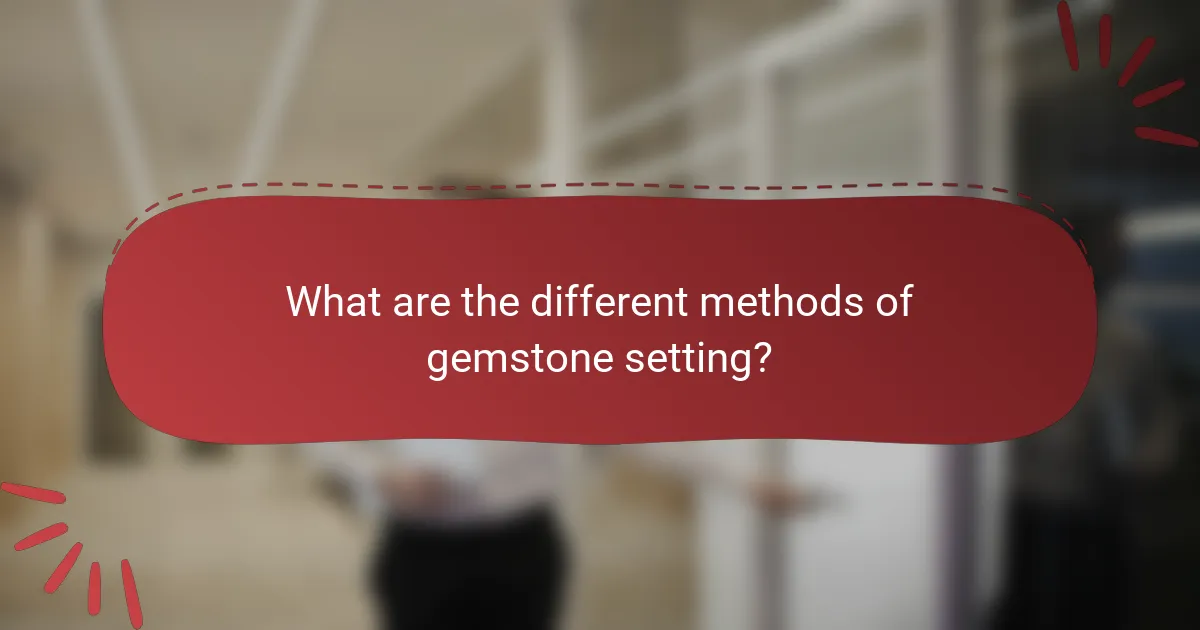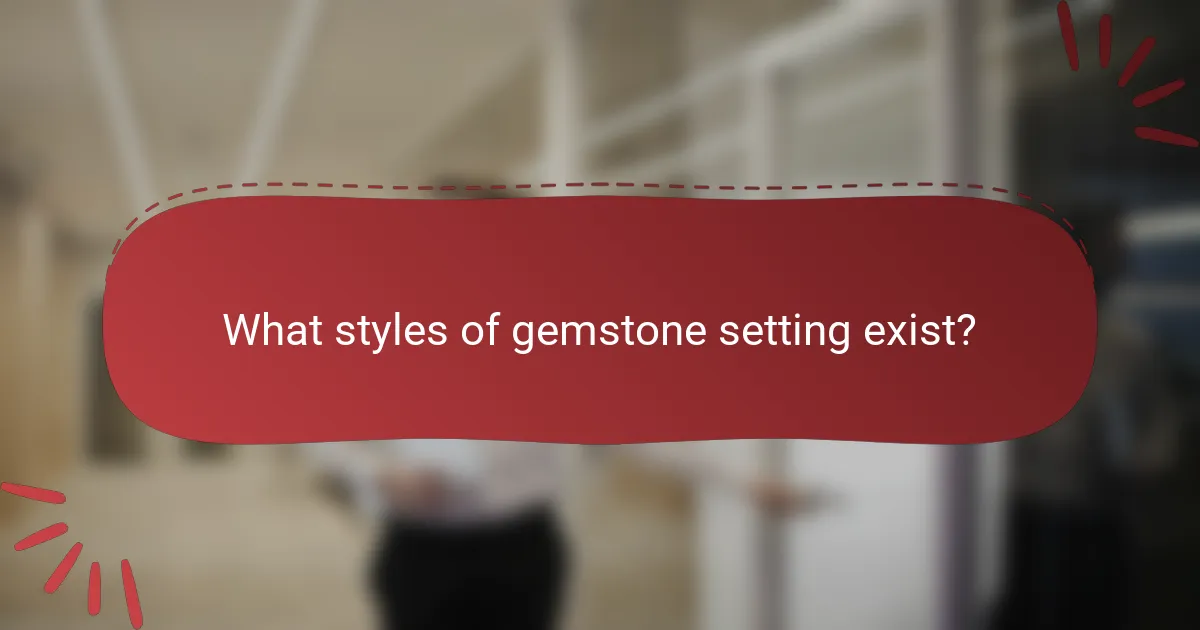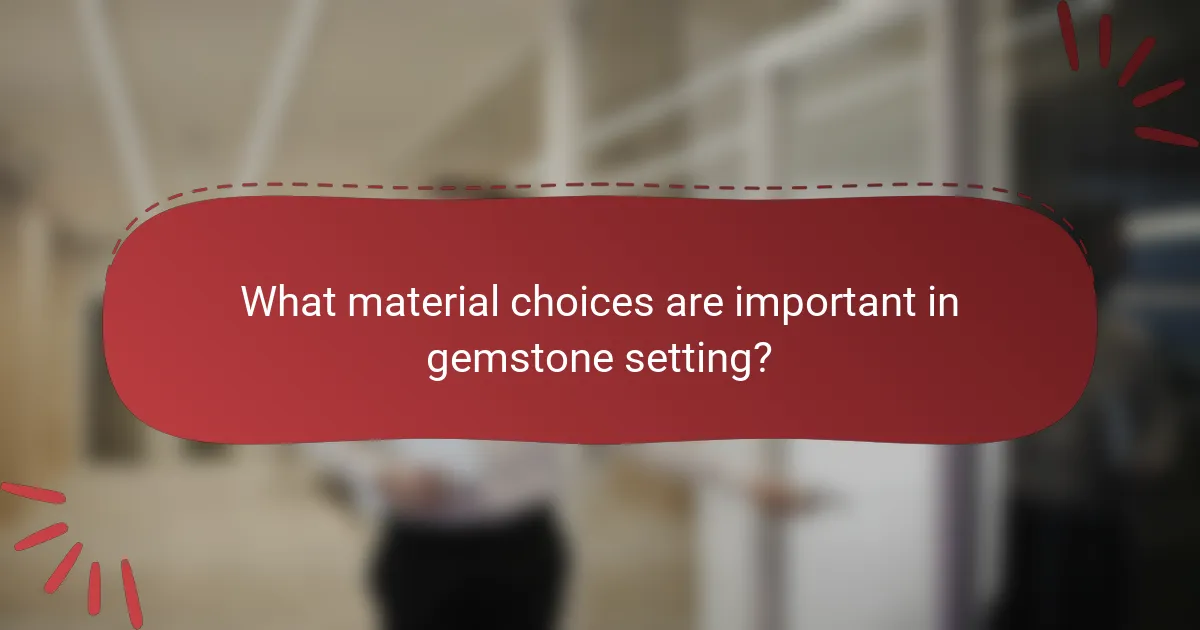The art of gemstone setting involves the secure placement of gemstones into jewelry, enhancing their aesthetic appeal and highlighting their beauty. Key methods of gemstone setting include prong, bezel, channel, pave, and tension settings, each offering distinct visual effects and purposes. Material choices, such as metals like gold, silver, and platinum, as well as the selection of gemstones based on their hardness and brilliance, play a crucial role in the effectiveness and longevity of the jewelry piece. This article explores the various techniques, styles, and material considerations essential to the craft of gemstone setting.

What is the Art of Gemstone Setting?
The art of gemstone setting is the craft of securely placing gemstones into jewelry. This process enhances the aesthetic appeal and showcases the stone’s beauty. Various techniques are employed, such as prong, bezel, and pave settings. Each method has its own unique characteristics and visual effects. Prong settings use metal claws to hold the stone, allowing maximum light exposure. Bezel settings encase the stone with a metal rim for added protection. Pave settings involve small stones set closely together to create a continuous surface. Mastery in gemstone setting requires precision, skill, and an understanding of materials. This art form has been practiced for centuries, evolving with trends and technology.
How does gemstone setting impact jewelry design?
Gemstone setting significantly impacts jewelry design by determining the overall aesthetic and structural integrity of the piece. The choice of setting influences how light interacts with the gemstone. For instance, a prong setting allows more light to enter, enhancing brilliance. Conversely, a bezel setting offers a sleek, modern look but may limit light exposure.
Different settings also affect the durability of the jewelry. For example, channel settings securely hold multiple stones, making them ideal for everyday wear. In contrast, tension settings create a floating appearance but may require careful handling.
Additionally, the setting style can dictate the design’s complexity. Intricate settings can elevate a simple design, while minimalist settings can highlight the gemstone’s natural beauty. Overall, the gemstone setting plays a crucial role in defining the jewelry’s character, functionality, and market appeal.
What are the key principles of gemstone setting?
The key principles of gemstone setting include security, visibility, and style. Security ensures the gemstone remains firmly in place. This is achieved through various techniques like prong, bezel, or channel settings. Visibility focuses on maximizing the gemstone’s brilliance and color. Proper positioning and minimal obstruction enhance its appearance. Style refers to the aesthetic alignment of the setting with the overall design. Different styles cater to personal taste and fashion trends. Together, these principles guide jewelers in creating effective and beautiful gemstone settings.
How does gemstone setting enhance the beauty of the stone?
Gemstone setting enhances the beauty of the stone by maximizing its visibility and brilliance. A well-executed setting allows light to enter and reflect off the facets of the gemstone. This interaction with light creates a dazzling display of color and sparkle. Different setting styles, such as prong, bezel, or pave, can accentuate various attributes of the stone. For example, prong settings lift the gemstone higher, increasing light exposure. Bezel settings provide a sleek, modern look while securing the stone. Each method of setting contributes to the overall aesthetic appeal. Properly chosen settings can also complement the stone’s color and cut. Thus, gemstone setting plays a crucial role in showcasing the stone’s natural beauty.
Why is gemstone setting considered an art form?
Gemstone setting is considered an art form because it combines technical skill with creativity. Artisans must master various techniques to securely hold gemstones in place. Each method, such as prong, bezel, or channel setting, requires precision and craftsmanship. The aesthetic appeal of the final piece relies on the artist’s design choices. Gemstone setting also involves understanding light and how it interacts with different cuts. This knowledge enhances the stone’s brilliance and overall visual impact. Historical significance further elevates gemstone setting as an art form, with traditions spanning centuries. Renowned jewelers have contributed to its evolution, showcasing innovative styles and techniques.
What skills are essential for a gemstone setter?
Essential skills for a gemstone setter include precision, attention to detail, and manual dexterity. Precision is crucial for accurately placing gemstones in settings. Attention to detail ensures that each facet of the gemstone is perfectly aligned. Manual dexterity allows for the intricate work required in setting stones securely. Additionally, knowledge of different gemstones and their properties is important. Understanding various setting techniques is also essential for creating aesthetically pleasing designs. Familiarity with tools and equipment used in gemstone setting further enhances a setter’s effectiveness. These skills collectively contribute to the quality and durability of the final piece.
How do cultural influences shape gemstone setting techniques?
Cultural influences significantly shape gemstone setting techniques through traditions, symbolism, and craftsmanship. Different cultures prioritize various gemstones based on local beliefs and values. For example, in India, intricate settings often reflect religious significance. In contrast, Western styles may emphasize minimalism and modern aesthetics.
Cultural heritage also dictates the choice of materials and techniques used in settings. For instance, Japanese craftsmanship is known for its precision and attention to detail in settings. Historical practices, such as the use of filigree in European jewelry, showcase how regional styles evolve over time.
Moreover, festivals and rituals can inspire specific designs, such as the use of colored stones in bridal jewelry across cultures. These influences create a diverse array of gemstone settings that reflect the unique identity of each culture.

What are the different methods of gemstone setting?
The different methods of gemstone setting include prong, bezel, channel, pave, and tension settings. Prong setting uses metal claws to hold the gemstone securely. This method allows maximum light to enter the stone. Bezel setting encircles the gemstone with a metal rim. It offers excellent protection for the stone. Channel setting places multiple stones in a row within a metal channel. This creates a seamless look. Pave setting involves tiny gemstones set closely together. It results in a glittering surface. Tension setting holds the gemstone in place with pressure from the band. This creates a modern, floating appearance. Each method has distinct characteristics and aesthetic appeal.
What are the most common gemstone setting techniques?
The most common gemstone setting techniques are prong, bezel, and pavé settings. Prong setting involves metal claws holding the gemstone securely in place. This technique allows maximum light to enter the stone, enhancing its brilliance. Bezel setting encases the gemstone in a metal rim. This method provides excellent protection for the stone while offering a sleek appearance. Pavé setting features small gemstones set closely together, creating a continuous surface of sparkle. Each technique serves different aesthetic and protective purposes, catering to various design preferences.
How does prong setting differ from bezel setting?
Prong setting differs from bezel setting in the way the gemstone is held in place. In a prong setting, small metal claws hold the gemstone at its edges, allowing maximum light exposure. This enhances the stone’s brilliance and sparkle. Conversely, a bezel setting encircles the gemstone with a metal rim, providing a secure and protective hold. This design offers a sleek, modern look but can limit light exposure. The choice between these settings affects both aesthetics and durability. Prong settings are often favored for their ability to showcase the gem, while bezel settings are preferred for their robust protection.
What is the process of pave setting?
Pave setting is a jewelry technique used to set small gemstones closely together. This method creates a continuous surface of stones without visible metal. First, small holes are drilled into the metal base to hold the stones. Next, each gemstone is placed into its hole. The jeweler then uses tiny beads of metal to secure the stones in place. This is done by pushing the metal over the edges of the stones. The result is a sparkling effect that enhances the overall appearance of the piece. Pave setting is commonly used in rings, bracelets, and earrings. It allows for maximum light exposure to the stones, creating brilliance.
How do advanced techniques enhance gemstone security?
Advanced techniques enhance gemstone security through innovative setting methods and protective technologies. These methods include the use of advanced materials, such as high-strength alloys and synthetic resins. They provide increased durability and resistance to wear. Techniques like laser engraving create unique identification marks on gemstones. This deters theft and ensures traceability. Additionally, security features like RFID tags can be embedded in settings. These tags allow for tracking and inventory management. Enhanced security measures reduce the risk of loss or damage. Overall, these advancements significantly improve the safety of gemstones in various settings.
What is the role of tension setting in modern jewelry?
Tension setting plays a crucial role in modern jewelry by securing gemstones without traditional prongs. This method allows for maximum light exposure, enhancing the stone’s brilliance. Tension settings create an illusion of the gemstone floating, which adds a contemporary aesthetic. The technique requires precise engineering to ensure the stone remains stable. This setting is popular in engagement rings and fashion jewelry. Tension settings can accommodate various shapes and sizes of gemstones. The design often emphasizes minimalism, appealing to modern tastes. Overall, tension setting combines artistry and functionality in jewelry design.
How does micro-pave setting create intricate designs?
Micro-pave setting creates intricate designs by using small gemstones set closely together. This technique allows for detailed patterns and shapes. Each stone is individually placed into tiny holes on the metal surface. The stones are held in place by small beads of metal, which are raised to secure the gems. This method maximizes the visual impact of the gemstones. It creates a seamless appearance, making the metal almost invisible. As a result, the design appears to be covered entirely in gemstones. Micro-pave settings are often used in high-end jewelry for their precision and elegance.

What styles of gemstone setting exist?
There are several styles of gemstone setting in jewelry design. The most common styles include prong setting, bezel setting, channel setting, and pave setting.
Prong setting uses metal claws to hold the gemstone securely. This style allows maximum light to enter the stone, enhancing its brilliance. Bezel setting surrounds the gemstone with a metal rim, offering protection and a sleek appearance.
Channel setting features a row of gemstones set into a groove, creating a continuous line of stones. This style is often used in wedding bands and bracelets. Pave setting involves small gemstones set closely together, creating a sparkling surface.
Each style serves a unique purpose and aesthetic in jewelry. These settings are foundational in the art of gemstone setting, showcasing the versatility and beauty of gemstones.
What are the traditional styles of gemstone setting?
Traditional styles of gemstone setting include bezel, prong, pavé, channel, and tension settings. Bezel setting encases the gemstone in metal, providing security and a sleek look. Prong setting uses metal claws to hold the gemstone, allowing maximum light exposure. Pavé setting features small stones set closely together, creating a continuous sparkle. Channel setting aligns gemstones in a groove, offering a smooth surface. Tension setting holds the gemstone in place through pressure, creating a floating appearance. Each style contributes distinct aesthetics and security for gemstones in jewelry.
How does antique setting differ from modern styles?
Antique setting differs from modern styles primarily in craftsmanship and design aesthetics. Antique settings often feature intricate detailing and hand-worked elements. These settings typically use traditional techniques that have been passed down through generations. In contrast, modern styles prioritize minimalism and clean lines. Modern settings often utilize machine-made components for precision. Additionally, antique settings may incorporate unique gemstones and historical motifs. Modern styles tend to favor contemporary materials and innovative designs. The emphasis on personal expression is stronger in antique settings compared to the standardized nature of many modern pieces.
What is the significance of vintage styles in contemporary jewelry?
Vintage styles in contemporary jewelry signify a deep appreciation for craftsmanship and history. These designs often reflect intricate detailing and unique aesthetics that modern pieces may lack. The resurgence of vintage styles connects consumers with past eras, evoking nostalgia and personal stories. Many contemporary jewelers incorporate vintage elements to create one-of-a-kind pieces that stand out in the market. Statistics show that vintage jewelry sales have increased by over 20% in recent years, highlighting consumer interest. This trend emphasizes sustainability, as vintage pieces promote reusability and reduce waste. Overall, vintage styles enrich contemporary jewelry with cultural significance and timeless appeal.
How do contemporary styles redefine gemstone setting?
Contemporary styles redefine gemstone setting by incorporating innovative designs and techniques. These styles emphasize minimalism and asymmetry, moving away from traditional symmetrical settings. They often utilize mixed metals and unconventional materials, enhancing visual appeal. Unique gemstone cuts are increasingly popular, allowing for creative placements. Contemporary designs prioritize the stone’s natural beauty, often showcasing it in a more prominent way. Additionally, settings now frequently include alternative gemstones, reflecting personal style over classic choices. This evolution aligns with modern consumer preferences for individuality and expression in jewelry.
What are the characteristics of minimalist gemstone settings?
Minimalist gemstone settings are characterized by their simplicity and elegance. These settings typically use minimal metal to showcase the gemstone. The focus is on the stone itself, often featuring clean lines and geometric shapes. They usually have a low profile, allowing the gemstone to sit close to the finger. The design often incorporates a single stone or a few stones for a subtle look. Materials used are often high-quality metals like platinum or gold, emphasizing durability and shine. This style is popular for engagement rings and everyday wear due to its versatility. Minimalist settings enhance the beauty of the gemstone without overwhelming it.
How does the use of asymmetry influence modern designs?
The use of asymmetry significantly influences modern designs by introducing balance through visual tension. Asymmetrical designs create a dynamic aesthetic that attracts attention. This approach allows for unique compositions that break traditional symmetry, making pieces more engaging. In gemstone setting, asymmetry can highlight the natural beauty of stones. It encourages creativity, enabling jewelers to explore unconventional arrangements. Research indicates that asymmetry can evoke emotional responses, enhancing the overall appeal of designs. By prioritizing asymmetry, modern designs differentiate themselves in a saturated market.

What material choices are important in gemstone setting?
The important material choices in gemstone setting include metals and gemstones. Common metals used are gold, silver, and platinum. Gold is popular for its durability and aesthetic appeal. Silver is more affordable but less durable than gold. Platinum is highly durable and hypoallergenic, making it suitable for sensitive skin.
Gemstones also play a crucial role in setting choices. Their hardness, brilliance, and color influence the setting style. For example, diamonds are often set in prong settings due to their hardness. Softer gemstones may require protective settings to prevent damage.
The choice of materials affects the overall design and longevity of the piece. A well-chosen combination enhances the beauty and security of the gemstone. Each material’s properties can significantly impact the final appearance and wearability of the jewelry.
What types of metals are commonly used in gemstone settings?
Common metals used in gemstone settings include gold, silver, and platinum. Gold is popular for its malleability and luster. It is available in various karats, with 14k and 18k being the most common for jewelry. Silver is favored for its affordability and bright appearance. Sterling silver, which is 92.5% pure, is the standard for quality. Platinum is valued for its strength and durability. It is hypoallergenic, making it suitable for sensitive skin. Other metals like palladium and titanium are also used, particularly in modern designs. Each metal offers unique benefits that cater to different preferences and styles in gemstone settings.
How does the choice of metal affect the overall design?
The choice of metal significantly influences the overall design of gemstone settings. Different metals offer distinct aesthetic qualities and structural properties. For example, gold provides a warm hue and is malleable, allowing intricate designs. Platinum, being denser and more durable, supports heavier stones and maintains its luster over time. Silver is more affordable and offers a bright finish but may tarnish. The metal’s color can enhance or contrast with the gemstone, affecting visual appeal. Additionally, the choice of metal impacts the weight and comfort of the piece when worn. This interplay between metal and gemstone is crucial in achieving a harmonious design.
What are the benefits of using precious versus non-precious metals?
Precious metals offer higher durability and resistance to tarnish compared to non-precious metals. Gold, silver, and platinum are less prone to corrosion. This longevity makes precious metals ideal for long-lasting jewelry. Precious metals also have a higher resale value. For example, gold retains its worth better than copper or aluminum. Additionally, precious metals are hypoallergenic, reducing the risk of skin irritation. Non-precious metals may cause allergic reactions in some individuals. Finally, precious metals provide a luxurious aesthetic that enhances the overall appeal of gemstone settings.
What factors influence the selection of gemstones for setting?
The selection of gemstones for setting is influenced by factors such as color, clarity, cut, and carat weight. Color affects the visual appeal and desirability of a gemstone. Clarity determines the stone’s purity and brilliance. Cut influences how light interacts with the gemstone, enhancing its sparkle. Carat weight impacts the size and value of the gemstone. Additionally, the intended use and design style play significant roles in gemstone selection. For example, certain settings may complement specific gemstone shapes or colors. Market trends and personal preferences also guide the choice of gemstones. High-quality gemstones with desirable attributes are often prioritized for premium settings.
How do gemstone hardness and durability impact setting choices?
Gemstone hardness and durability significantly influence setting choices. Hardness is measured on the Mohs scale, which ranks gemstones from 1 (talc) to 10 (diamond). Gemstones with higher hardness, like sapphires and diamonds, are more resistant to scratches and damage. This allows for more intricate and exposed settings, such as prong settings, which showcase the stone’s brilliance.
Durability encompasses hardness, toughness, and stability. Tougher stones, like jade, withstand impacts better, allowing for secure settings. Softer stones, like opals, require protective settings to prevent chipping. Therefore, softer gemstones often use bezel settings to shield their edges.
In summary, hardness and durability dictate the choice of settings based on the stone’s ability to withstand wear and tear. This ensures that the gemstone remains secure and visually appealing over time.
What role does color play in selecting gemstones for specific styles?
Color is a crucial factor in selecting gemstones for specific styles. It influences the overall aesthetic and emotional appeal of jewelry. Different colors evoke various feelings and associations, impacting design choices. For instance, blue sapphires are often chosen for their elegance in formal wear. In contrast, vibrant colors like pink tourmaline may complement casual styles. Additionally, color harmonizes with metal types, enhancing the visual effect. For example, warm-toned gemstones pair well with yellow gold. Research indicates that color psychology affects consumer preferences, guiding selection processes. Thus, understanding color’s role is essential for effective gemstone styling.
What are the best practices for gemstone setting?
The best practices for gemstone setting include ensuring a secure fit, selecting appropriate materials, and maintaining aesthetic balance. A secure fit prevents the gemstone from loosening or falling out. Use high-quality metals like gold or platinum for durability. Choose a setting style that complements the gemstone’s shape and size. Prong settings are common for showcasing brilliance, while bezel settings offer protection. Ensure the setting allows for light to enter the stone, enhancing its sparkle. Regular maintenance checks can prevent damage. Following these practices leads to lasting and visually appealing jewelry.
How can one ensure the longevity of a gemstone setting?
To ensure the longevity of a gemstone setting, regular maintenance is essential. Cleaning the setting helps remove dirt and oils that can weaken it. Use a soft brush and mild soap for gentle cleaning. Inspect the setting frequently for loose stones or damage. This allows for timely repairs before further issues arise. Store jewelry properly to avoid scratches and damage. Use a soft pouch or a separate compartment in a jewelry box. Avoid exposing the setting to harsh chemicals, which can degrade materials. Following these practices can significantly extend the life of a gemstone setting.
What common mistakes should be avoided in gemstone setting?
Common mistakes in gemstone setting include improper sizing of the setting. An incorrectly sized setting can lead to loose stones or damage. Another mistake is neglecting to secure the stone properly. This can result in the gemstone falling out. Failing to choose the right setting material is also a frequent error. Certain materials may not provide adequate support for specific gemstones. Additionally, not accounting for the gemstone’s hardness can lead to scratching or chipping. Overlooking the symmetry of the design can affect the overall aesthetic. Lastly, rushing the setting process often leads to mistakes. Taking time ensures precision and quality in the final piece.
The main entity of the article is gemstone setting, which refers to the craft of securely placing gemstones into jewelry to enhance their beauty and aesthetic appeal. The article covers various methods of gemstone setting, including prong, bezel, pave, channel, and tension settings, each with unique characteristics and visual effects. It also discusses the impact of gemstone setting on jewelry design, key principles guiding the craft, essential skills for gemstone setters, cultural influences, and the significance of material choices, including metals and gemstones. Additionally, the article highlights best practices for ensuring the longevity of gemstone settings and common mistakes to avoid in the setting process.